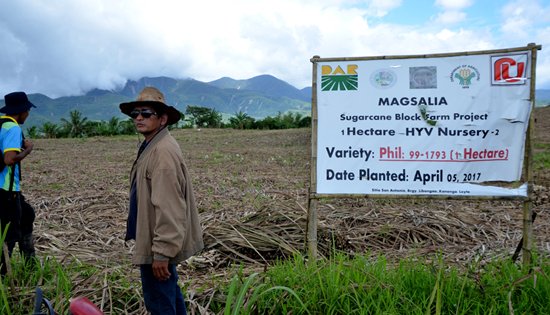|

Magsasaka
ng Libongao Farmers Association (MAGSALIA) President
Reynaldo Francisco show their one-hectare demo farm after
the harvest. According to him, they were able to harvest
73.1 tons of sugarcane, an increase of 28 tons under the
sugar block farm. |
Sugar block farm
doubles the harvest
Press Release
October 1, 2018
TACLOBAN CITY –
“Halos mag doble ang na harvest namo karon!” (“Our harvest now is
almost double!”), said Reynaldo Francisco as he excitedly reported
their harvest in sugarcane this season in their one-hectare demo
farm.
Francisco, one of the 29
agrarian reform beneficiaries (ARBs) in the 30-hectare lot once
owned by the Jonases, and president of the Magsasaka ng Libongao
Farmers Association (MAGSALIA) in Kananga, Leyte, reported that they
harvested 73.1 tons in their demo farm.
According to him,
“MAGSALIA is now the envy of other sugar plantation owners in our
town because of our very high return of investment in sugar
production”.
Before, like other sugar
farmers, they could only harvest an average of 40 to 45 tons in a
hectare lot.
But now, our production
nearly doubled because of the Sugar Block Farm Project (SBFP)
introduced to us in 2017 by the Department of Agrarian Reform (DAR),
Francisco exclaimed.
SBFP is one of the
projects under the Program Beneficiaries Development (PBD) component
of the Comprehensive Agrarian Reform Program (CARP) that
continuously provide farmers and farm workers, specifically the ARBs,
with the opportunity to enhance their dignity and improve the
quality of their lives through greater productivity of agricultural
lands.
It is in partnership with
the Sugar Regulatory Administration (SRA), per Republic Act No.
10659 or the Sugarcane Industry Development Act, as assistance
provided to ARB organizations (ARBOs) in sugarland areas where small
landholdings are consolidated to achieve economies of scale.
In Region-8, MAGSALIA is
one of the only two ARBO-recipients of the SBFP.
Aside from SRA, DAR also
commissioned the services of RU Foundry to provide the technology in
sugar production that would lead to an increased income.
Francisco disclosed that
RU Foundry; which is based in Bacolod City, another sugar producing
area; taught them the tractor spike style of planting, which truly
gave them higher production. “Tractor spike or clamp technology” was
new to them as it was not practiced in Region-8.
They were also taught
intercropping with crops such as peanut, corn, mongo and white
beans, which no one does here. It gave them additional income,
Francisco added.
They likewise spent less
because they use vermicast instead of applying purely commercial
fertilizer. The vermicast or organic fertilizer is produced by the
association as additional livelihood introduced by DAR.
DAR also provided us with
the necessary equipment like the 120-horse power four-wheel drive
tractor and a 10-wheeler heavy-duty dump truck that are used in the
land preparation and hauling saving us from high rentals, Francisco
further shared. Instead, our association earn by offering the
machines for rent, he added.
When asked how much they
earned from this season in sugar block farm (SBF), Jimmy Dejon,
MAGSALIA Farm Manager, disclosed that their grossed income reached
P168,831 from sugar sales (P149,932), molasses (P10,780), intercrop
(P3,000) and trucking allowance/incentive (P37,063).
Deducting the P128,768
they spent in their operation from the gross income, MAGSALIA gained
P40,063 from SBF on a hectare plantation alone. How much more if the
entire 30 hectares owned by the members intended for this project be
utilized?
That is why, members of
the association, who used to earn as low as P1.50 a day as sugar
farmworkers in the 70s, are excited to go full blast on SBF.
Since the members, who are
just ordinary farmers, don’t have the capital, while the association
neither could afford to finance the entire operation, MAGSALIA
members are now availing of loan under the Agricultural Production
Credit Program (APCP) from the Land Bank of the Philippines at 8.5
percent annual interest rate.
To other small sugarland
owners, Francisco is encouraging them to join their association and
double their harvest.
MAGSALIA started in 1990
with 32 members only. All of them were ARBs contributing P100 each
to form their capital build-up (CBU).
Now, the association has
expanded to 111 members where 58 are ARBs and with total assets
reaching P9.6-million mostly derived from lending, the major service
offered by them through the years.